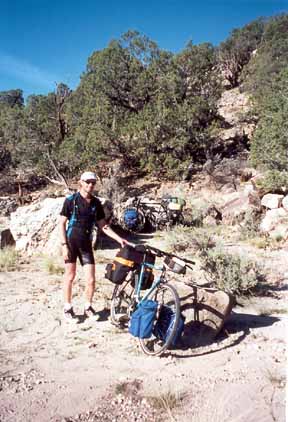It's amazing how quickly the daily occurrences on a bike tour become routine.
The nuances of "normal" life - day after day staring at a computer for eight hours a day, driving home, making dinner, reading the paper, and going to bed - suddenly seem distant and strange. Peddling along a crumbling highway in the hot September sun - this seems normal.
As soon as routine begins to kick in, general truths come into view. On my recreational rides, hills were always an ominous presence, something to be avoided if possible. Here, in southwestern Colorado, they're just part of life. The foothills of the San Juan mountains roll away in the distance as far as I can see, gently caressing the San Miguel River Basin in a symbiotic wave, and in making my way over them, I learned that the general effort on a hill is always in your favor.
See, since most longer rides, regardless of distance, start and end at about the same elevation, the general truth of "what goes up must comes down" applies. Say you go up a five-mile long hill at maximum effort, moving at 5 mph. You reach the top, and start barreling down at 40 mph, tears streaming down your cheeks, smile stretched across your face - needless to say, you are exerting no effort. Though your average speed is only 9 mph, generally less than the flatland average, total energy exerted is only 50 percent per mile, also less than the flatland average, which hovers around 75. A steady stream of hills and drops allows you much needed rests wihtout stopping, plus it breaks up themonotany. So yes, I believe in the long run, hills are to your advantage.
Here are a few other "rules" of bike touring that I have found to be truth.
The amount of room a vehicle leaves you while passing on the highway is inversely related to its size: small sedans will give you an entire lane while 18-wheelers are content to edge you into the shoulder as they
blow by at 60 mph. Oncoming traffic is almost never a factor in this case.
Do not collect the loose bolts on the road. What starts as a quaint souvenir of a road trip becomes a 20 pound zip lock bag filling up your rear pannier.
Foods that do not require refrigeration: mustard, cheese, produce, fruit, and mayonnaise.
Foods that do require refrigeration: BUTTER! ( I learned this at the expense of a perfectly good cotton T-shirt)
I don't care what anyone tells you, but chocolate is THE perfect bicycling/backpacking food. It's tasty, it's compact, and at 150 calories per ounce, with a few pounds and a jar of multivitamins, you
could head out into the wilderness for a month. In theory.
Padded biking shorts are a necessity. I was once a scoffer myself, but a few 70 mile rides in nylon cargo pants have shown me the error of my ways.
Bicycling jerseys, on the other hand, are a waste of money. Unless you are trying to shave two tenths of a second off each mile of a 3,000 mile trip, don't bother with head-to-toe skin tight clothing. Unless, of course, you bought the bicycle jersey because it is made of non-cotton material. Anything non-cotton is good. Cotton = wet and cold for an entire day.
It doesn't matter how thick your tires are, your bike will always jackknife if you hit the breaks on a patch of ice. This rule applies to cars as well.
The best camp sites are nearly always the ones you just happen upon after walking your bike through the mud for half a mile.
Do not burn dry cowpies. While a good rule of thumb for surviving a cold night in an area that's short on timber, this does not make for a pleasant campfire experience.
The morning hours just before sunrise are really the best time for bicycling. Traffic is sparse, the lighting is good, and it really works up an appetite for a big breakfast. However, crawling out of a warm sleeping bag before the sun comes up is damn near impossible.
When staying at a motel, avoid getting a room on the upper deck; 90 pound bikes do not go up stairs.
Before leaving on the trip, print out some "business cards," detailing your point of departure, destination, average speed, average mileage per day, and the phrase, "Yes, I do get tired." This is a quick and easy way to answer all questions you are likely to hear a million times.
And, finally, the unknown is the reason for putting one pedal in front of the other. Never fear it.

